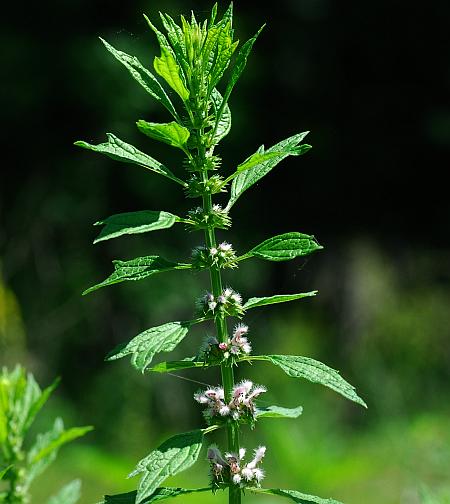Leonurus cardiaca L.
Motherwort

Introduced
CC = *
CW = 5
MOC = 42
© SRTurner
Leonurus cardiaca L.Motherwort | |
 |
Introduced CC = * CW = 5 MOC = 42 |
© SRTurner |
|
Family - Lamiaceae Habit - Perennial forb with fibrous roots and rhizomes. Stems - Erect, to 1.5 m, sometimes multiple, simple or branching, strongly 4-angled, glabrous or sparsely pubescent with short, fine, downward-angled hairs, often mostly on the angles.
Leaves - Opposite, petiolate. Petioles to 13 cm, 4-angled, densely pubescent and hirsute on upper angles. Blades 1-12 cm long, those of the lower leaves palmately 5-9 lobed and broadly ovate to nearly circular in outline, grading into those of the median and upper leaves, which are unlobed or 3-lobed and ovate to elliptic in outline, the margins having a few, coarse, sharp teeth, variously rounded to narrowly angled or tapered at the base, angled or tapered to a sharply pointed tip, the upper surface glabrous to pubescent with short, stiff, loosely appressed hairs near the margins, the undersurface sparsely to moderately pubescent with fine, loosely appressed hairs, mostly along the veins.
Inflorescence - Dense axillary clusters of numerous sessile flowers almost completely surrounding stem, appearing whorled. Bractlets shorter than to about as long as the calyces, linear, often spinescent at the tips.
Flowers - Calyces 3.5-8.0 mm long, strongly 5-nerved, the nerves thickened into ribs, the teeth about as long as the tube, glabrous or sparsely and minutely hairy, also usually with numerous minute, club-shaped glands. Corollas bilabiate, tubular, constricted near base, 8-12 mm long, distinctly longer than the calyces, white to pink (the lower lip with reddish purple spots or mottling), moderately short-hairy externally, but the upper lip densely pubescent with longer, spreading hairs. Tube to 6 mm long, 2.2 mm in diameter. Lower lip reduced, 3-lobed. Lateral lobes small, recurved and folding under central lobe. Central lobe to 2 mm long, attenuate, deflexed or slightly recurving, mottled with maroon near apex of throat. Upper lip 5-6 mm long, 3 mm broad, densely lanate above, obtuse, pink. Stamens 4, with the anther sacs parallel. Filaments white, to 1.6 mm long, lanate at the base. Style 1, glabrous, positioned between upper pair of stamens. Stigma 2-lobed.
Fruits - Nutlets 4, 1.7-2.3 mm long, truncate at the tip.
Flowering - May - August. Habitat - Forests openings, riverbanks, marshes, ledges and tops of bluffs, pastures, fields, gardens, railroads, roadsides, open disturbed areas. Origin - Native to Eurasia. Lookalikes - L. japonicus, L. marrubiastrum,. Other info. - ...So I'm driving home and I spot a good planting of Delphinium ajacis. I decided to stop and take some snaps. Upon returning to my car I reached for my keys only to discover them still in my ignition and behind locked doors. The passenger window was cracked open a bit so I decided to look for some wire and fish my keys out. As I walked around an abandoned building I found not only some good wire, but also the plant pictured above. The moral of the story? Always have a spare set of keys handy and ALWAYS have your camera. Photographs taken off Mill Rd., Platte County, MO., 5-3-00, and in Marquette, MI., 7-27-02 (DETenaglia); also in Gallatin Conservation Area, Daviess County, MO, 6-13-2014 (SRTurner). |